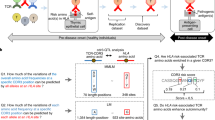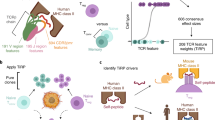Abstract
THE major histocompatibility complex (MHC) in the ninth linkage group of the mouse encodes antigens that stimulate strong alloreactions1. In vitro studies have focused on two such reactions, both mediated by T lymphocytes. Cytotoxic T cells can recognise products of the MHC H–2K and D regions (KD antigens), and can be distinguished by their Ly antigen phenotype from the non-cytotoxic T lymphocytes that give their strong proliferative responses in mixed leucocyte culture (ref. 2) (MLC). These latter cells respond primarily to H–2 I region gene products1,2. The products of a second genetic locus in the mouse also stimulate strong MLC responses. This Mls locus3 behaves as a single autosomal dominant gene mapping in linkage group 13. It has been defined by studying MLC reactions between MHC identical strains of mice. Interestingly, it has not been possible to induce cytotoxic effector T cells against Mls locus antigens4. Recent interest in T cell responses to antigen has focused on the crucial role of MHC gene products in antigen recognition (reviewed in refs 5–8). These studies have shown that T cell responses to most conventional antigens involve recognition of both the foreign antigen and self MHC antigens. In parallel with allogeneic reactions, T cells cytotoxic to antigen-modified self cells see that antigen plus self KD molecules, while helper T cells, T cells mediating delayed type hypersensitivity and T cells proliferating in vitro to soluble antigens recognise the antigen in association with I region gene products. Thus, virtually all T cell responses involve recognition of MHC gene products, with the possible exception of responses to Mls locus antigens. Reactions to Mls locus antigens, however, are normally tested between MHC identical strains of mice, so responses to Mls locus antigens may also involve recognition of self MHC antigens, probably encoded in the I region7. Alternatively, the Mls locus might represent I region gene duplications translocated to another chromosome3,9. The present experiments were designed to test these ideas. We report that T cell responses to Mls locus antigens involve recognition of the products of two gene clusters. One gene cluster is clearly self MHC genes, probably within the I region, while the second is almost certainly the genes of the Mls locus. Thus, virtually all T cell responses to non-MHC antigens involve specific recognition of self-MHC antigens in association with another antigenic determinant.
This is a preview of subscription content, access via your institution
Access options
Subscribe to this journal
Receive 51 print issues and online access
$199.00 per year
only $3.90 per issue
Buy this article
- Purchase on Springer Link
- Instant access to full article PDF
Prices may be subject to local taxes which are calculated during checkout
Similar content being viewed by others
References
Schreffler, D. C. & David, C. S. Adv Immum. 20, 125–195 (1975).
Cantor, H. & Boyse, E. A. J. exp. Med. 141, 1376–1389 (1975).
Festenstein, H. Transplant. Rev. 15, 62–90 (1973).
Peck, A. B. & Bach, F. H. Scand. J. Immun. 4, 53–62 (1974).
Raff, M .C. Nature 263, 10–11 (1976).
Doherty, P. C., Götze, D., Trinchieri, G. & Zinkernagel, R. Immunogenetics 3, 517–524 (1976).
Janeway, C. A., Jr, Wigzell, H. & Binz, H. Scand. J. Immun. 5, 993–1001 (1976).
Paul, W. E. & Benacerraf, B. Science (in the press).
Peck, A. B. Folia Biol. (Praha) 22, 38–40 (1976).
Peck, A. B., Andersson, L. C. & Wigzell, H. J. exp. Med. (in the press).
Gordon, R. D., Simpson, E. & Samelson, L. E. J. exp. Med. 142, 1108–1120 (1975).
Bevan, M. J. Immunogenetics 3, 177–184 (1976).
Katz, D. H., Graves, M., Dorf, M. E., Dimuzio, H. & Benacerraf, B. J. exp. Med. 141, 263–268 (1975).
Janeway, C. A., Jr Scand. J. Immun. 5, 593–596 (1976).
Wigzell, H., Sundqvist, K. G. & Yoshida, T. O. Scand. J. Immun. 1, 75–87 (1972).
Peck, A. B. & Click, R. E. Eur. J. Immun. 3, 385–392 (1973).
Author information
Authors and Affiliations
Rights and permissions
About this article
Cite this article
PECK, A., JANEWAY, C. & WIGZELL, H. T lymphocyte responses to Mls locus antigens involve recognition of H-2 I region gene products. Nature 266, 840–842 (1977). https://doi.org/10.1038/266840a0
Received:
Accepted:
Issue Date:
DOI: https://doi.org/10.1038/266840a0
This article is cited by
-
Role of the T cell receptor α-chain in superantigen recognition
Immunologic Research (1996)
-
T-cell receptor Vβ use predicts reactivity and tolerance to Mlsa- encoded antigens
Nature (1988)
-
The expression of Mls c determinants on Mls a , Mls b , and Mls x prototypic strains
Immunogenetics (1988)
-
H-2-linked genes determine the level of the primary in vitro anti-Mls response
Immunogenetics (1986)
-
Soluble Mlsa antigens: Stimulatory effect in vitro versus suppressive effect in vivo
Immunogenetics (1984)
Comments
By submitting a comment you agree to abide by our Terms and Community Guidelines. If you find something abusive or that does not comply with our terms or guidelines please flag it as inappropriate.



